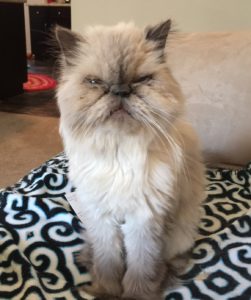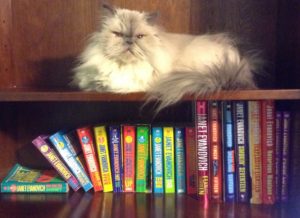Vomiting In Cats: Morgan’s Story

Morgan
When vomiting in cats is more than just fur balls
Cat parents all recognize that familiar sound when our cat is about to throw up: gluck, gluck, gluck… It’s certainly not a fun experience for the cat or the person having to clean up the mess. Especially when it happens in the middle of the night when your cat is sleeping right next to you! Or if you wake up in the middle of the night and happen to step in it on your way to the bathroom! Seriously though, frequent vomiting in cats can be a sign that something is wrong.
This past week I met an adorable Himalayan kitty named Morgan. His mom, Vickie, reached out to me for help. In the past several weeks and months she lost two cats: one to kidney failure and the other most likely from cancer. Morgan is around 11 years old and lives indoors with five other cats. He is a very picky eater and only wanted to eat dry food which concerned Vickie greatly. She was also concerned because he would vomit up his food, had runny eyes, and his ears bothered him. Morgan was also very close to the kitty who recently passed away. Vickie suspected he may be grieving because he was very clingy and would get very upset when she would leave the house. His most recent vet exam didn’t reveal anything too unusual for a cat his age either.
Why do cats vomit?
There are lots of reasons why cats vomit including a change in diet, food sensitivity, IBD, cancer, parasites, bacterial or viral infections, pancreatitis, cancer, fur balls, a foreign body, liver/kidney/thyroid disease and even diabetes. When I looked at Morgan’s case, taking into account that he exhibited several symptoms of food sensitivity, it was likely that food was the culprit.
Using a method called energy testing I was able to determine that Morgan’s vomiting resonated with food intolerance. Cats who are sensitive to food can also exhibit runny eye, itchy or inflamed ears, and even skin irritations. The next thing I had to do was analyze the food he was eating: Purrfect Bistro Turkey and Duck (kibble), Fromm’s Game Bird recipe (kibble) and Fromm’s Hasen Duckenpffer recipe (kibble). While all these are good brands, the ingredients used to make kibble are not.
Kibble and carbohydrates
In order to make kibble manufacturers have to use a carbohydrate to make it all “stick together.” Even if your cat’s food is labeled grain-free, often times the food still contains carbohydrate ingredients like peas, potatoes, chickpeas, lentils and even quinoa. Carbohydrates are broken down as sugar during digestion. (Ideally the amount of carbs should be around 5%) Because some of these ingredients also have a protein component (amino acid chains), pet food makers can artificially inflate the protein percentages on the label. Keep in mind: cats are carnivores and do not digest carbohydrates or plant proteins well. This can result in vomiting, chronic inflammation, pancreatitis, gas, and other GI issues.
As it turned out, many ingredients just didn’t agree with Morgan’s body:
- Purrfect Bistro Turkey and Duck: Chicken meal, Potatoes, Peas, Potato Protein, Dried Whey Protein Concentrate, and Choline Chloride. This recipe contains 29.5% carbs and 40% protein (artificially inflated with non-animal proteins).
- Fromms Game Bird recipe: Pea Protein, Peas, Pea Flour, Potatoes, Chicken Cartilage. This recipe contains 31% carbs and 35% protein. (artificially inflated with non-animal proteins)
- Fromm’s Hasen Duckenpfeffer recipe: Peas, Potatoes, Chickpeas, Lentils, Pea Protein, Pea Fiber. This recipe contains 33% carbs and 34% protein (artificially inflated with non-animal proteins).
Other sensitivities
The energy testing evaluation also revealed that Morgan was sensitive to chicken and wet food; the emotions of grief and clingy behavior; wet food; and ears. Using a technique called energetic cellular release (ECR) I was able to remove these sensitivities. His body released any strong holds to these things, and now he move forward without dis-ease.
Working towards a better diet
Vickie is now working to transition Morgan and all the other household cats off the kibble on to a wet diet. She is offering a combination of food grade canned and freeze-dried cat food and plans to try introducing raw food as well. While it can take time for a cat to adapt to a new diet, a new food texture or type, it’s worth the struggle and patience. Morgan apparently has decided he likes the rehydrated freeze-dried food, so he’s already moving in the right direction!
How do you determine if your cat’s grain-free food has carbs in it? Check out this article. Thank you for sharing this post with other cat lovers!
Having cat issues? Learn more about the Optimal Cat Health Analysis here. Sign up to follow our blog here.

